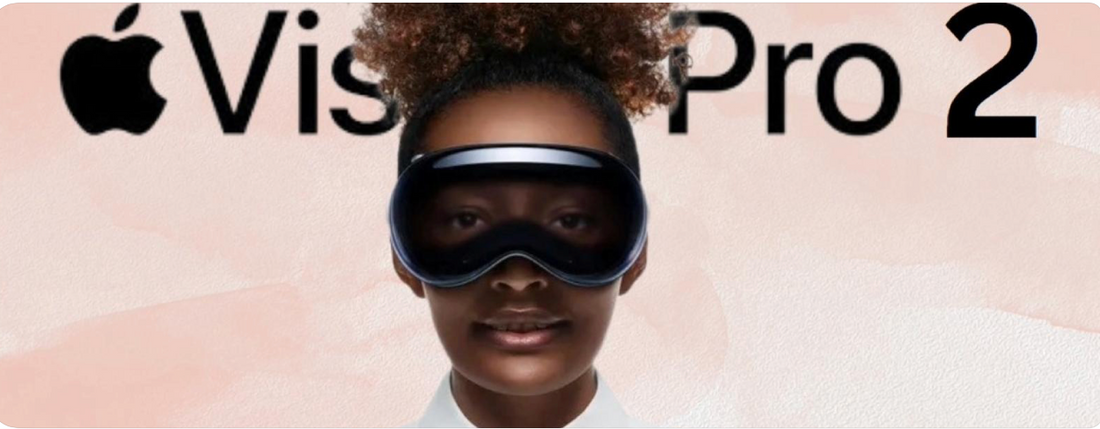
Apple Vision Pro 2: The Future of Reality Just Got an Upgrade
Share
In October 2025, Apple officially unveiled its next-gen spatial-computing headset: the Vision Pro 2. This sleek wearable marks a meaningful upgrade over its predecessor, blending advanced hardware and refined software to push how we interact with digital and physical worlds.
Here’s a breakdown of what makes it noteworthy, where it shines, and where it might still leave you wanting.
What’s new & upgraded
-
The Vision Pro 2 is powered by the M5 chip (alongside the R1 sensor-processor), delivering stronger graphics performance, improved AI processing, and enhanced efficiency.
-
Display improvements: it supports up to a 120 Hz refresh rate (up from 100 Hz in the original), enabling smoother motion and more fluid interactions.
-
Battery life is modestly extended: up to ~2.5 hours in general use, and ~3 hours of video playback.
-
Ergonomics enhanced: introducing a “Dual Knit Band” head-strap design for improved comfort and fit.
-
Software & ecosystem: ships with visionOS 26 and supports the growing library of spatial apps, plus improved integration with existing Apple devices and workflows.
Why it matters
-
Spatial computing goes mainstream: With the Vision Pro 2, Apple is doubling down on mixed reality (MR) — blending physical and digital spaces. This is more than just VR gaming; it’s about productivity, collaboration, immersive viewing, and new forms of interaction.
-
Hardware stepping-up: The jump to M5 and 120 Hz makes a tangible difference in experience — less blur, more fluid UI, stronger capabilities. It signals that Apple expects usage beyond occasional novelty.
-
Ecosystem leverage: For those already invested in Apple’s ecosystem (iPhone, iPad, Mac), the Vision Pro 2 becomes an extension of that—sharing apps, devices, continuity features.
-
Developer opportunity: With higher performance and new sensors, developers have a richer platform to build immersive apps, whether for design, education, entertainment, or collaboration.
What it does really well
-
Premium build and design — Apple’s hallmark. The headset looks and feels like a flagship product meant to explore new device categories.
-
Smooth interaction and UI — thanks to better refresh rate and chip. It should feel more polished than many older or competing MR headsets.
-
Great for plug-into workflows: virtual displays, spatial media, presentations, remote collaboration in a more immersive format.
-
Comfortable enough for short-to-medium sessions thanks to the improved strap + hardware refinement.
What to keep in mind
-
Price & value: At around $3,499 (for the base model) it remains a high-end, premium device.
-
Battery life remains limited: 2.5 – 3 hours is better than before — but for a full day’s use it still falls short unless plugged in.
-
Weight & form factor: With added hardware, it’s still a headset — the bulk and weight may limit comfort for long sessions.
-
Content / ecosystem maturity: While Apple’s platform is growing, widespread dedicated MR apps are still somewhat niche compared to traditional computing or mobile apps.
-
Use-case clarity: If you’re thinking “just better VR headset for gaming,” it may not check all the boxes — its strengths lie more broadly in spatial computing, productivity, mixed reality, not purely gaming.
Looking ahead: Why this matters for the future
The Vision Pro 2 isn’t just “another gadget” — it signals where Apple thinks the next major leap in personal computing will come from: spatial, immersive, integrated. As software catches up (AI, apps, services) and as workflows adapt (remote work, creative collaboration, mixed-reality experiences), devices like this could redefine how we live, work, and connect.
For tech-enthusiasts and professionals alike, this is a device worth watching — and possibly investing in — if you’re ready to be early in a new computing paradigm. If you’re more conservative, it may be a “wait-and-see” play until the ecosystem matures further or prices come down.
